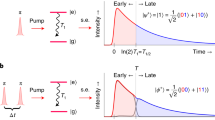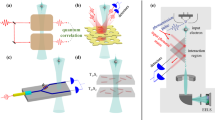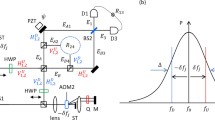Abstract
Entangled photon pairs—discrete light quanta that exhibit non-classical correlations—play a crucial role in quantum information science (for example, in demonstrations of quantum non-locality1,2,3,4,5,6,7, quantum teleportation8,9 and quantum cryptography10,11,12,31). At the macroscopic optical-field level non-classical correlations can also be important, as in the case of squeezed light13, entangled light beams14,15 and teleportation of continuous quantum variables16. Here we use stimulated parametric down-conversion to study entangled states of light that bridge the gap between discrete and macroscopic optical quantum correlations. We demonstrate experimentally the onset of laser-like action for entangled photons, through the creation and amplification of the spin-1/2 and spin-1 singlet states consisting of two and four photons, respectively. This entanglement structure holds great promise in quantum information science where there is a strong demand for entangled states of increasing complexity.
This is a preview of subscription content, access via your institution
Access options
Subscribe to this journal
Receive 51 print issues and online access
$199.00 per year
only $3.90 per issue
Buy this article
- Purchase on Springer Link
- Instant access to full article PDF
Prices may be subject to local taxes which are calculated during checkout




Similar content being viewed by others
References
Clauser, J. F. & Shimony, A. Bell's theorem: experimental tests and implications. Rep. Prog. Phys. 41, 1881–1927 (1978).
Aspect, A., Dalibard, J. & Roger, G. Experimental test of Bell's inequalities using time-varying analyzers. Phys. Rev. Lett. 49, 1804–1807 (1982).
Ou, Z. Y. & Mandel, L. Violation of Bell's inequality and classical probability in a two-photon correlation experiment. Phys. Rev. Lett. 61, 50–53 (1988).
Shih, Y. H. & Alley, C. O. New type of Einstein-Podolski-Rosen experiment using pairs of quanta produced by optical parametric down-conversion. Phys. Rev. Lett. 61, 2921–2924 (1988).
Tittel, W., Brendel, J., Zbinden, H. & Gisin, N. Violation of Bell inequalities by photons more than 10 km apart. Phys. Rev. Lett. 81, 3563–3566 (1998).
Weihs, G., Jennewein, T., Simon, C., Weinfurter, H. & Zeilinger, A. Violation of Bell's inequality under strict locality conditions. Phys. Rev. Lett. 81, 5039–5043 (1998).
Pan, J.-W. et al. Experimental test of non-locality in three-photon Greenberger-Horne-Zeilinger entanglement. Nature 403, 515–519 (2000).
Boumeester, D. et al. Experimental quantum teleportation. Nature 390, 575–579 (1997).
Boschi, D. et al. Experimental realization of teleporting an unknown pure quantum state via dual classical and Einstein-Podolski-Rosen channels. Phys. Rev. Lett. 80, 1121–1125 (1998).
Ekert, A., Rarity, J. G., Tapster, P. R. & Palma, G. M. Practical quantum cryptography based on two-photon interferometry. Phys. Rev. Lett. 69, 1293–1295 (1992).
Jennewein, T., Simons, C., Weihs, G., Weinfurter, H. & Zeilinger, A. Quantum cryptography with entangled photons. Phys. Rev. Lett. 84, 4729–4732 (2000).
Tittel, W., Brendel, J., Zbinden, H. & Gisin, N. Quantum cryptography using entangled photons and energy-time Bell states. Phys. Rev. Lett. 84, 4737–4736 (2000).
Slusher, R. E. et al. Observation of squeezed states generated by four-wave mixing in an optical cavity. Phys. Rev. Lett. 55, 2409–2412 (1985).
Wu, L. A., Kimble, H. J., Hall, J. L. & Wu, H. Generating squeezed states by parametric down-conversion. Phys. Rev. Lett. 57, 2520–2523 (1986).
Ou, Z. Y., Pereira, S. F., Kimble, H. J. & Peng, K. C. Realization of the Einstein-Podolski-Rosen paradox for continuous variables. Phys. Rev. Lett. 68, 3663–3666 (1992).
Furusawa, A. et al. Unconditional quantum teleportation. Science 282, 706–709 (1998).
Kwiat, P. G. et al. New high-intensity source of polarization-entangled photon pairs. Phys. Rev. Lett. 75, 4337–4341 (1995).
Kok, P. & Braunstein, S. L. Postselected versus non-postselected quantum teleportation using parametric down-conversion. Phys. Rev. A 61, 042304-1–042304-10 (2000).
Simon, C., Weihs, G. & Zeilinger, A. Optical quantum cloning via stimulated emission. Phys. Rev. Lett. 84, 2993–2996 (2000).
Ou, Z. Y., Rhee, J.-K. & Wang, L. J. Observation of four-photon interference with a beam splitter by pulsed parametric down-conversion. Phys. Rev. Lett. 83, 959–962 (1999).
Bouwmeester, D. et al. Observation of three-photon Greenberger-Horne-Zeilinger entanglement. Phys. Rev. Lett. 82, 1345–1349 (1999).
De Martini, F., Mussi, V. & Bovino, F. Schroedinger cat states and optimum universal quantum cloning by entangled parametric amplification. Opt. Commun. 179, 581–589 (2000).
DeMartini, F. & Di Giuseppe, G. Multiparticle quantum superposition and stimulated entanglement by parity selective amplification of entangled states. Z. Naturforsch. 56, 61–66 (2001).
Weinfurter, H. & Zukowski, M. Four photon entanglement from down conversion. Preprint quant-ph/0103049 at 〈http://xxx.lanl.gov〉 (2001).
Knill, E., Laflamme, R. & Milburn, G. J. A scheme for efficient quantum computation with linear optics. Nature 409, 46–52 (2001).
Atature, M. et al. Partial distinguishability in femtosecond optical spontaneous parametric down-conversion. Phys. Rev. Lett. 83, 1323–1326 (1999).
Herzog, T. J., Rarity, J. G., Weinfurter, H. & Zeilinger, A. Frustrated two-photon creation via interference. Phys. Rev. Lett. 72, 629–632 (1994).
Milonni, P. W., Fearn, H. & Zeilinger, A. Theory of two-photon down-conversion in the presence of mirrors. Phys. Rev. A 53, 4556–4566 (1996).
Cregan, R. F. et al. Single-mode photonic band gap guidance of light in air. Science 285, 1537–1539 (1999).
Kim, J., Takeuchi, S. & Yamamoto, Y. Multiphoton detector using visible light photon counter. Appl. Phys. Lett. 74, 902–904 (1999).
Naik, D. S., Peterson, C. G., White, A. G., Berglund, A. J. & Kwiat, P. G. Entangled state quantum cryptography: eavesdropping on the Ekert protocol. Phys. Rev. Lett. 84, 4733–4736 (2000).
Acknowledgements
We thank C. Mikkelsen, P. Varisco, W. Irvine, A. Ekert and J. Rarity for suggestions and experimental support. This work was supported by the EPSRC, the UK Defence Evaluation and Research Agency, and the European QuComm project.
Author information
Authors and Affiliations
Corresponding author
Rights and permissions
About this article
Cite this article
Lamas-Linares, A., Howell, J. & Bouwmeester, D. Stimulated emission of polarization-entangled photons. Nature 412, 887–890 (2001). https://doi.org/10.1038/35091014
Received:
Accepted:
Issue Date:
DOI: https://doi.org/10.1038/35091014
This article is cited by
-
Localization-enhanced moiré exciton in twisted transition metal dichalcogenide heterotrilayer superlattices
Light: Science & Applications (2023)
-
Microtubules as a potential platform for energy transfer in biological systems: a target for implementing individualized, dynamic variability patterns to improve organ function
Molecular and Cellular Biochemistry (2023)
-
Quantum interferometric generation of polarization entangled photons
Scientific Reports (2018)
-
Interlayer valley excitons in heterobilayers of transition metal dichalcogenides
Nature Nanotechnology (2018)
-
On four-photon entanglement from parametric down-conversion process
Quantum Information Processing (2018)
Comments
By submitting a comment you agree to abide by our Terms and Community Guidelines. If you find something abusive or that does not comply with our terms or guidelines please flag it as inappropriate.



